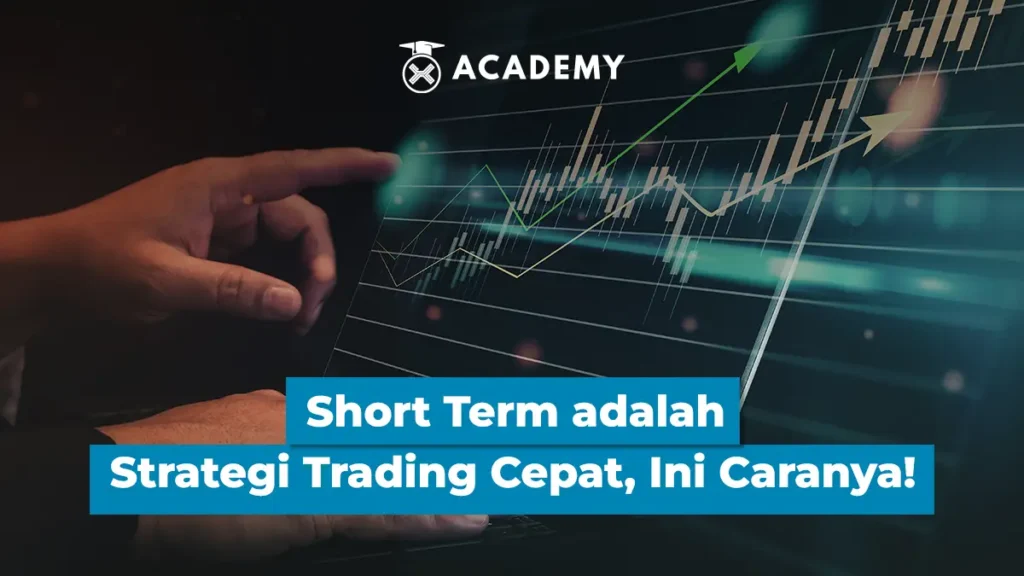Short-term trading is a trading strategy that lasts for a short period of time, ranging from a few minutes to a few days.
Traders who use this approach usually take advantage of market volatility to make quick profits from relatively small price changes.
In this article, we will discuss short-term trading, how it differs from long-term trading, some popular strategies that are often used by traders, and their advantages and risks.
What is Short Term? Definition & Basic Concepts in Trading

Short-term trading is a strategy where traders open and close positions within a short period of time, ranging from minutes, hours, to days.
The main goal of this approach is to take advantage of small price fluctuations in a short period of time to make quick profits.
In this strategy, traders use various technical analysis methods and utilize price movement patterns to make decisions.
Instruments that can be traded in short-term trading include stocks, forex, and cryptocurrencies, all of which have high volatility and large liquidity.
Although it offers the opportunity for quick profits, short-term trading also has high risks due to rapid and often unpredictable price movements.
Therefore, success in this strategy depends heavily on technical analysis skills, strict risk management, and fast and precise execution. The following are types of assets that can be traded in the short term:
1.Stocks
In the world of stocks, short-term trading strategies are often carried out through methods such as day trading and swing trading.
- Day trading: Traders open and close positions within one day to avoid overnight risk.
- Swing trading: Positions are held for several days to capture the momentum of larger price movements.
1.Forex
Foreign exchange or forex trading is also very popular among short-term traders. Some of the strategies used include:
- Scalping: A strategy with the aim of making small profits in a very short time, often in minutes.
- Intraday trading: Traders open and close positions within one day, but with a longer time frame than scalping.
1.Crypto
The crypto market, which is known for its volatility, is also often the choice of short-term traders. The methods used include:
- Day trading: Similar to day trading in stocks, positions are opened and closed within the same day.
- Arbitrage: Traders buy assets on one platform and sell them on another platform to take advantage of price differences.
Meanwhile, the characteristics of short-term trading that are important to know are as follows:
1.Focus on Short-Term Price Volatility
Short-term traders rely on fast and sharp price movements in a short period of time. Therefore, market volatility is the main factor that determines profit opportunities.
1.Need Strong Technical Analysis
Because decisions must be made in a short time, short-term traders rely more on technical analysis than fundamental analysis.
They study price patterns, trading volume, and technical indicators to determine when to enter and exit the market.
1.Using Technical Indicators
Some indicators commonly used in short-term trading include:
- Relative Strength Index (RSI) : Measures the strength of a price trend and helps identify overbought or oversold conditions.
- Moving Average: Shows the direction of a price trend based on the average movement of the price over a certain period.
- Bollinger Bands: Helps measure market volatility and identify breakout or reversal opportunities.
People Also Read: Memecoin Trading Strategy for Beginners: Complete Guide
Differences Between Short-Term and Long-Term Trading
Short-term trading and long-term trading are two different strategies in the world of investing and trading, each with its own unique approach, risks, and goals. Here are the main differences between the two:
1. Trading Timeframe
Short-term trading: Positions are opened and closed within a short period of time, ranging from minutes, hours, to days.
Long-term trading: Positions are held for a longer period of time, which can be weeks, months, or even years.
2. Analysis Approach
Short-term trading: Relies more on technical analysis, such as price patterns, trading volume, and indicators such as RSI, Moving Average, and Bollinger Bands.
Long-term trading: Prioritizes fundamental analysis, such as financial statements, economic conditions, and long-term asset growth prospects.
3. Goals and Strategies
Short-term trading: Aims to gain quick profits from short-term price volatility. Traders often use strategies such as scalping, day trading, and swing trading.
Long-term trading: Aims to profit from long-term trends by buying assets that have the potential to grow in value. Common strategies used are value investing and growth investing.
4. Transaction Frequency
Short-term trading: High transaction frequency, with many trades made in a day or several days.
Long-term trading: Low transaction frequency because positions tend to be held for a long time.
5. Risk and Volatility
Short-term trading: Higher risk because prices can change rapidly in a short period of time. Traders must be prepared for high volatility.
Long-term trading: Lower risk if based on strong fundamentals, but still susceptible to macroeconomic changes and market cycles.
6. Capital and Transaction Costs
Short-term trading: Requires a large enough capital to cover more frequent transaction costs, including spreads, commissions, and other fees.
Long-term trading: Lower transaction costs because of lower trading frequency, but requires patience in waiting for investment results.
People Also Read This: What is Crypto Scalping Trading Technique? Beginners Must Know!
Popular Short-Term Trading Strategies
Short-term trading is the choice for many traders who want to make quick profits in a short time.
In this strategy, there are several popular methods that are often used, such as Scalping, Day Trading, Swing Trading, and Breakout Trading. Here is the review:
1. Scalping
Scalping is a trading method that focuses on a very short timeframe, usually only in seconds to a few minutes.
Traders who use this strategy try to make small profits from fast and repeated price movements in a day.
By relying on technical indicators such as Moving Average, RSI, and Bollinger Bands, they determine entry and exit points quickly.
The main advantage of scalping is the potential profit that can be collected gradually in small amounts but often.
However, the high frequency of transactions can increase trading costs, and small mistakes can lead to large losses.
2. Day Trading
Day Trading is a strategy where traders open and close positions in one day without leaving the position open until the next day.
This strategy takes advantage of daily volatility to find profit opportunities in one trading session. Indicators such as the Stochastic Oscillator, MACD, and candlestick patterns are used to read price movements.
The advantage of day trading is that traders do not need to worry about price changes outside of trading hours, thus reducing the risk of overnight gaps.
However, this strategy requires quick decision-making and high discipline because prices can be very volatile in a day.
3. Swing Trading
Swing Trading is a strategy that aims to capture price trends over several days to several weeks.
Traders look for momentum when prices are trending up or down and hold positions until the trend provides optimal profit.
Technical analysis such as support & resistance, trendlines, and RSI and MACD indicators are used to determine the right entry and exit.
This strategy allows traders to gain greater profits than scalping or day trading because positions are held longer.
However, the risk is also greater because trends can change suddenly, especially due to news or other fundamental factors.
4. Breakout Trading
Breakout Trading is a strategy that relies on price movements when breaking through strong support or resistance levels.
Traders wait for the breakout moment and enter the market in the hope that the trend will continue after passing a certain level.
Indicators such as Bollinger Bands, Volume, and Moving Average are often used to confirm the strength of the breakout.
This strategy is very effective in volatile markets, such as crypto, because significant price movements often occur after a breakout.
However, if the breakout turns out to be a false breakout, the price can return to the previous level and cause losses for the trader.
Advantages & Risks of Short-Term Trading

Short-term trading is a trading strategy that focuses on transactions in a short period of time, ranging from minutes to several days.
This method is in great demand because it offers the opportunity for quick profits, especially in dynamic markets such as crypto and stocks.
However, behind its potential profits, short-term trading also has risks that need to be considered. Here are some of the advantages and risks that need to be understood before jumping into it.
1. Advantages of Short-Term Trading
1.Potential for quick profits
With the right strategy, short-term trading allows traders to make a profit in a short time without having to wait long like long-term investments.
This is suitable for those who want instant results and don’t want their capital to be left idle for too long.
1.More flexible
Traders can adjust their trading methods according to their preferences and styles, be it scalping, day trading, or swing trading. This flexibility also allows traders to adjust their strategies to market conditions.
1.Taking advantage of price volatility
Markets with high price movements, such as crypto or stocks with large trading volumes, can provide more frequent profit opportunities.
With a good strategy, traders can take advantage of rapid price spikes or drops.
2. Risks of Short-Term Trading
1.More susceptible to price fluctuations
Rapid price movements can be a double-edged sword. If the analysis is wrong or there is a sudden change in trend, losses can occur in a short time, even in minutes or seconds.
1.Need technical analysis skills
Traders must understand various aspects of technical analysis such as price patterns, indicators, and market momentum to increase profit opportunities. Without sufficient understanding, short-term trading can become high-risk speculation.
1.Higher transaction costs
Because transactions are made more frequently, the costs incurred for spreads, commissions, or other transaction costs can be greater than long-term trading.
If not calculated properly, these costs can erode the profits obtained.
People Also Read This: Getting to Know Bollinger Bands from How They Work to How They Are Used
Short-Term Trading Success Tips for Beginners
Short-term trading can be an attractive opportunity for beginners, but without the right strategy, the risks are also quite high. Here are some tips that can help you increase your chances of success in short-term trading:
1. Use Stop-Loss
Setting a stop-loss is very important to limit losses if the price moves against expectations. With a stop-loss, you can avoid losing a large amount of capital.
2. Learn technical indicators
Understanding indicators such as RSI, Moving Average, and Fibonacci Retracement will help you analyze price movements and determine the right moment to enter or exit the market.
3. Use capital wisely
Don’t be tempted to use all your capital in one transaction. Manage your capital well and avoid overtrading which can make you run out of funds faster.
4. Practice your strategy with a demo account
Before using real capital, try practicing your strategy with a demo account. This will help you understand market dynamics without the risk of losing real money.
5. Monitor news and market sentiment
External factors such as economic news, government policies, or market sentiment can suddenly affect price movements. Always update information so as not to get caught in a detrimental situation.
Conclusion
Well, that was an interesting discussion about Short Term is a Fast Trading Strategy, Here’s How! which you can read in full at the Crypto Academy at INDODAX Academy.
Short-term trading is a strategy that focuses on transactions in a short period of time by taking advantage of price volatility.
Some of the methods commonly used in this strategy include scalping, day trading, and swing trading, each with a different approach and level of risk.
The main advantage of short-term trading is the potential for profit that can be obtained quickly. However, the risks involved are also quite large, especially if you do not have a mature strategy.
Therefore, it is important to choose a strategy that suits your risk profile and investment goals.
So, are you interested in trying short-term trading? Come on, start your crypto trading journey at INDODAX right now!
FAQ
1.What is short-term trading?
Short-term trading is a strategy of buying and selling assets in a short period of time, ranging from minutes to several days.
2.What is the difference between short-term and long-term trading?
Short-term trading focuses on quick profits from price movements, while long-term trading is more about long-term investment.
3.What is the best strategy for short-term trading?
Scalping, day trading, and swing trading are the strategies most often used by short-term traders.
4.Is short-term trading suitable for beginners?
Suitable if you understand technical analysis, but beginners should try a demo account first before using real capital.
5.Can short-term trading be done on INDODAX?
Yes, INDODAX allows short-term crypto trading with various technical analysis features.





 Polkadot 8.91%
Polkadot 8.91%
 BNB 0.54%
BNB 0.54%
 Solana 4.81%
Solana 4.81%
 Ethereum 2.37%
Ethereum 2.37%
 Cardano 1.35%
Cardano 1.35%
 Polygon Ecosystem Token 2.11%
Polygon Ecosystem Token 2.11%
 Tron 2.85%
Tron 2.85%
 Market
Market


